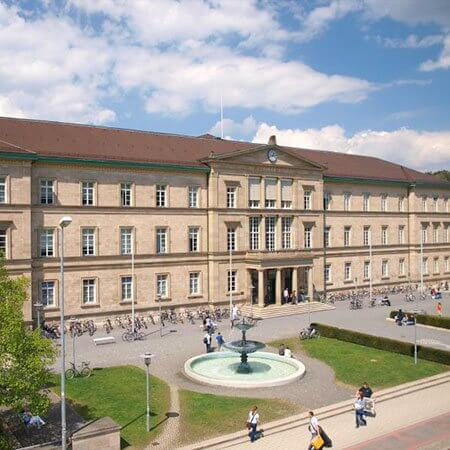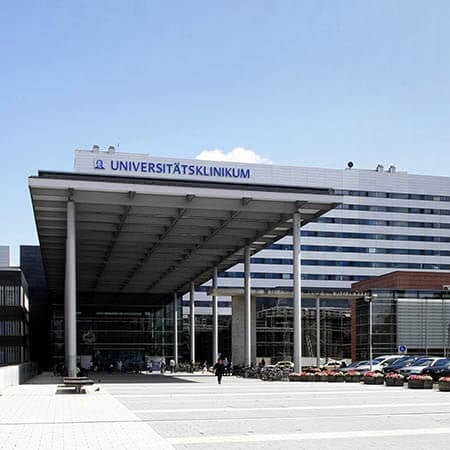Worldwide breast cancer awareness makes many women think that each breast neoplasm is essential. However, most breast changes are benign, and most women are more likely to be diagnosed with a non-cancerous breast condition. Benign breast still requires medical attention, such as careful examination, distinguishing from breast cancer, and choosing the most appropriate therapy despite not being life-threatening. In Germany, treatment for breast tumors includes drug therapy, fine needle aspiration, and surgery. German hospitals offer reliable techniques with excellent therapeutic and aesthetic results and a reasonable cost of treatment in Germany.
Content
- Fibrosis and Simple Cysts
- Hyperplasia (Ductal or Lobular)
- Lobular Carcinoma in Situ
- Adenosis
- Fibroadenomas
- Phyllodes Tumors
- Intraductal Papillomas
- Mastitis
- Radial Scars and Other Non-cancerous Breast Conditions
- Planning treatment in Germany
Fibrosis and Simple Cysts
The somewhat outdated common name for fibrosis and simple cysts is "fibrocystic disease." Fibrosis is an excessive proliferation of connective tissue around the ducts of each breast lobule. Areas of fibrosis are firm and can be palpated. Cysts are filled with fluid sacs inside the breast glandular tissue. They are tender and change throughout the menstrual period. Fibrocystic changes can develop at any age, being more common in women of child-bearing age. They do not put women at higher risk of breast cancer.
Asymptomatic fibrocystic changes do not require any treatment. Lifestyle modifications are recommended, such as avoiding caffeine and other stimulants, wearing supportive bras, and taking over-the-counter painkillers before the menstruation.
Patients with severe symptoms may benefit from the treatment with birth control pills or androgens. Draining cysts with the help of thin needles is also performed. The action reduces pressure inside the cyst and relieves pain. Complicated and complex cysts, as well as large fibrotic masses, may require surgery. In Germany, healthcare specialists give preference to organ-preserving interventions.
Hyperplasia (Ductal or Lobular)
Hyperplasia is an excessive proliferation of cells that line ducts inside the mammary gland or its lobules. Although ductal and lobular hyperplasia are not cancer, certain their types are linked with a higher risk of breast cancer development. These are atypical ductal and lobular hyperplasia, in which the cells look irregular and abnormal under a microscope. On the contrary, cells look similar to normal ones in patients with usual ductal and lobular hyperplasia.
Hyperplasia is detected with the help of a mammogram; a physician or a woman herself cannot feel a tumor during palpation. Surgical or fine-needle aspiration biopsy is used for the diagnosis confirmation. Treatment of hyperplasia depends mainly on histological examination of the harvested breast tissue.
Usual ductal hyperplasia requires only follow-up examinations, including a mammogram and breast ultrasound scan. Patients with atypical ductal and lobular hyperplasia undergo surgery with the removal of the suspicious tissues and normal breast tissues, after with a higher risk of breast cancer.
Lobular Carcinoma in Situ
Lobular carcinoma in situ (LCIS) is a neoplasm in the lining of the lobules that consists of cancer-like looking cells. Oncologists do not consider LCIS cancer, as it never spreads beyond the lobule. Even without any therapy, LCIS does not invade the wall of the lobule. However, this condition increases the risk of developing invasive breast cancer in either mammary gland.
There are different histological types of lobular carcinomas in situ. These are classic(consists of small and uniform cells), pleomorphic(consists of larger and abnormal cells), and florid tumors(consists of large cellular groups with central necrosis ). All the conditions are suspected according to the results of the mammogram. A biopsy is required to confirm the diagnosis.
In Germany, excisional Biopsy or more extensive breast-conserving surgeries are carried out in women with pleomorphic and florid LCIS, as these pathologies are more likely to multiply. Chemotherapy or any other additional measures are not administered. Active surveillance is recommended for women with classic LCIS.
Adenosis
Adenosis is a non-Cancerous condition of the mammary gland in which its lobules are enlarged abnormally. Enlarged lobules can be similar to a breast tumor during palpation, thus located close to one another. Adenosis can also be sclerosing when the abnormal lobules are distorted by scar-like fibrous tissue. In this case, a physical breast exam is not enough to presuppose the nature of the neoplasm.
However, a mammogram can also be insufficient for the diagnosis confirmation, as calcifications can be present in the areas of adenosis. This makes it hard to distinguish adenosis from breast cancer. Surgical or FINE-needle aspiration biopsy is the gold standard for examination in this case.
According to the biopsy findings, women with adenosis who do not require cancer treatment are excluded. In breast discomfort or other clinical manifestations, medicines (hormones, food supplements, painkillers, etc.) or surgery may be considered. In Germany, preference is given to non-invasive therapy.
Fibroadenomas
Fibroadenomas are often diagnosed in women of child-bearing age, as their development is connected with the influence of female hormones on the sensitive epithelial and connective tissue. Correspondingly, fibroadenomas shrink and can even go away spontaneously after a patient goes through menopause. Small tumors are asymptomatic and cannot be detected during the self-examination; an ultrasound scan or mammogram is the diagnostic necessity in this case. As a fibroadenoma grows, a woman can feel it as a rubbery or firm nodule and move it under the skin.
Biopsy of the mammary gland allows for distinguishing fibroadenomas from breast cancer and other pathologies and distinguishing simple fibroadenomas from complex ones.
As for the therapy, a wait-and-see approach is used first. Asymptomatic neoplasms without signs of active growth may be left untreated. In this case, surgical treatment is connected with more risks and possible complications than possible benefits. The same time, women with fibroadenomas that change the shape of the mammary gland or demonstrate active growth are candidates for surgical treatment.
Phyllodes Tumors
Phyllodes tumors originate in the connective tissue of the mammary gland. This is a rare breast condition, but physicians from the specialized German hospitals are experienced enough to make the correct diagnosis. Phyllodes tumors are often connected with the inherited genetic condition – Li-Fraumeni syndrome. They develop in women of any age, being diagnosed more often in women in their 40s.
A core needle or excisional biopsy is performed. According to the subsequent histological examination results, phyllodes tumors are divided into benign, borderline, and malignant ones. The last type of phyllodes tumors accounts for about 1 in 4 cases.
Surgical treatment is indicated in all cases. Benign neoplasms are removed during the excisional Biopsy without any additional therapeutic measures. Borderline and malignant neoplasms require removal of the area of normal tissue around; lumpectomy or mastectomy can be performed. Cancer treatment in Germany is comprehensive, and radiotherapy might be given to the diseased area after surgery. Phyllodes tumors demonstrate a poor response to chemotherapy, so chemotherapy is administered only to ineligible patients.
Relapses of borderline and malignant phyllodes tumors are possible, so close follow-up is recommended after the completion of therapy.
Intraductal Papillomas
Intraductal papillomas are benign tumors that resemble warts and grow inside the milk ducts of the mammary gland. They can be solitary and multiple; the cellular composition includes gland tissue, fibrous tissue, and vascular tissue.
Solitary intraductal papillomas often cause nipple discharge, including the bloody one next to the nipple. Thus, breast cancer is often suspected.
In addition to mammogram and breast ultrasound scan, a ductogram is included into the diagnostic protocol. Ductogram implies injecting dye into the nipple duct and the subsequent X-ray examination of the mammary gland. Biopsy is also performed in the presence of indications.
Therapy is based on surgical intervention. Size, number, and localization of intraductal papillomas are considered first. Papillomas are removed with the part of the correspondent milk duct. Chemotherapy or other suppressive systemic treatments are not administered.
Mastitis
Mastitis is an inflammatory infiltration in the breast. It is always benign and not connected with THE risk of developing breast cancer in the future. Mastitis is caused by an infectious agent and is most often diagnosed in breastfeeding women.
Diagnosis is based on a patient's complaints and A physical breast examination results. However, German healthcare professionals distinguish mastitis from inflammatory breast cancer.
Treatment is mainly conservative; a woman receives antibiotics and painkillers. In the case of poor response to such therapy within a week, A skin biopsy is performed to exclude inflammatory breast cancer.
Radial Scars and Other Non-cancerous Breast Conditions
Radial scars, or complex sclerosing lesions, are mostly accidental findings. They may imitate Cancer on the mammogram and lead to misdiagnoses. Radial scars are asymptomatic in most cases, but doctors still recommend removing them.
Other benign mammary tumors are:
- Lipomas (tumors originating from fatty tissue)
- Hemangiomas (tumors originating from blood vessels)
- Hematomas (large blood clots)
- Adenomyoepitheliomas (tumors originating from rare cells of milk duct walls)
- Hamartomas (an excessive proliferation of the diverse mature breast cells)
- Neurofibromas (tumors originating from nerve endings)
- Granular cell tumors (tumors originating from Schwann cells)
Even with benign breast changes, women who do not feel safe can undergo bilateral prophylactic mastectomy. This is the removal of both breasts that excludes the risk of breast cancer in the future. Such an option may be reasonable in women with cases of breast cancer in family history or women with BRCA gene mutation. In Germany, prophylactic mastectomy is followed by reconstruction of mammary glands so that no one will know about your treatment. High quality and reasonable cost of treatment in Germany allow avoiding unnecessary risks in women from the high-risk Cancer group.
Planning treatment in Germany
Booking Health is the well-known medical tourism operator that has been organizing the examination and treatment of women with breast tumors from 75 countries in the leading German hospitals for over 12 years.
Booking Health services include:
- Choosing the most suitable healthcare facility based on its qualification profile
- Establishing communication directly with the selected physician
- Preparing the preliminary medical program without repeating previous diagnostic tests
- Providing favorable cost of treatment in Germany, excluding additional price coefficients for foreign patients (saving up to 50%)
- Making the appointment on the suitable date
- Independent monitoring of a medical program
- Help in buying and forwarding of medicines and medical products
- Keeping in touch with German hospitals after treatment completion
- Control of prices and invoices, return of unspent funds
- Organization of additional diagnostic tests, interventions, cancer prevention, rehabilitation, etc.
- Booking accommodation and plane tickets, organization of transfer
- Services of interpreter and personal medical coordinator
To start planning treatment in German hospitals, leave your request at the Booking Health website. A patient case manager or medical advisor will contact you the same day to discuss all the details, including cost of treatment in Germany for your clinical case. Aim of our work is to help you improve and maintain your health.
Authors:
This article was edited by medical experts, board-certified doctors Dr. Nadezhda Ivanisova, and Dr. Bohdan Mykhalniuk. For the treatment of the conditions referred to in the article, you must consult a doctor; the information in the article is not intended for self-medication!
Our editorial policy, which details our commitment to accuracy and transparency, is available here. Click this link to review our policies.
Sources:
Medscape
Web MD
PubMed




















